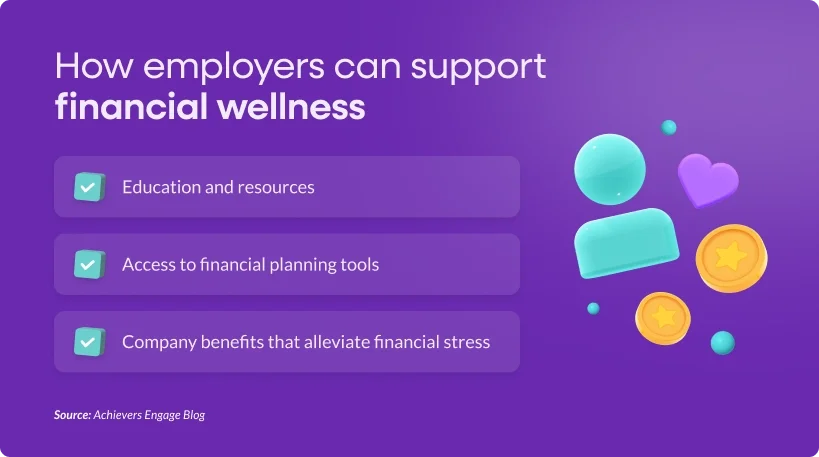Table of contents
Not everyone is comfortable discussing money at work, but employee financial well-being directly impacts performance. According to a 2024 SoFi report, one in four employees say financial stress lowers their productivity, motivation, and focus.
On the flip side, financially secure employees are more productive and goal oriented. Beyond fair pay, employers can boost financial wellness by offering financial education, access to advisors, and benefits that support personal financial goals.
In this blog, we’ll explore how supporting employee financial wellness can drive positive outcomes for employers, too. Read to dive in? Let’s go!
What is the meaning of financial wellness?
Financial wellness is your ability to comfortably meet current and future financial needs while feeling secure and in control. It’s not just about income — it’s about how you manage money, handle debt, and make informed decisions. It also includes your financial literacy and confidence in using available tools and resources to support both your goals and daily life.
How do you practice financial wellness?
You can practice financial wellness by budgeting, managing debt, saving for future goals, and improving your financial literacy. This includes learning about credit, investment options, and financial products, and working with advisors when needed. By taking small, intentional steps, you can gain more control, reduce stress, and build confidence in your financial future.
What is an example of financial well-being?
Financial well-being means being able to enjoy life without financial stress — like taking a vacation without going into debt or covering an emergency expense with savings. It’s about feeling secure, confident, and in control of your money. Everyone’s financial well-being looks different, but the common thread is peace of mind and stability.
The link between financial stress and employee wellness
Financial stress can work its way into all aspects of a person’s life. Organizations need to take financial stress seriously because it can negatively impact employee engagement and wellness. Financial stress can impact sleep patterns, mental health, and motivation. With 25% of employees reporting that financial stress impacts their performance at work, organizations that invest in financial wellness are investing in employee motivation, retention, and productivity.
Increased stress and burnout
When employees are worried about finances, they’re more likely to struggle with focus, engagement, and morale. Employees who face financial stress report struggling with sleep, relationships, mental health, and taking on a second job, all of which can lead to a decline in productivity as they struggle to focus and stay engaged at work.
Stress and burnout are critical risk factors for employee retention and engagement, but what can companies do when the stressors are external or personal? Financial wellness programs that help employees manage their relationship with money are preventative measures for dealing with financial stress before it becomes overwhelming.
Lower productivity and absenteeism
Employees feeling financial stress are more likely to take time off (absenteeism) or become distracted at work (also known as presenteeism). Absenteeism and presenteeism can reduce productivity and cause spinoff issues for employees who are engaged, such as higher workloads, more demands on their time, and worse results across the board. Stress leads to distraction because it overwhelms the attention system, creating a feedback loop of anxiety and distraction. It can be tough for an individual to set those anxieties and distractions aside when they come to the workplace, impacting their performance and reducing productivity.
Mental and physical health impact
SoFi’s 2024 report found that 47% of employees face issues with mental health due to financial stress, and 36% report struggling with their physical health because of financial stress. Chronic financial stress can lead to anxiety, depression, and physical health problems. Research has repeatedly shown a connection between chronic stress and physical health issues, including issues such as back pain, stomach aches, and extremely painful headaches. Trying to work with any of these issues will impact performance.

How employers can support financial wellness
Employers are in a unique position to support their employees’ financial wellness. SoFi found that one-third of employees expressed a desire to improve their financial literacy — double the rate of employees they found in their last report. People are eager to improve their financial wellness, and they trust their managers as sources of financial advice.
- Education and resources: Offering financial literacy programs, workshops, and coaching is a great place to start. Financial wellness starts with understanding credit tools, taxes, debt, saving, and investing.
- Access to financial planning tools: Helping employees, budget, save, and invest will set them up for long-term success. While 28% of employees have expressed that they would like access to a financial advisor through their company, only 35% of companies offer financial planning services. Empower your employees to make smart financial decisions through financial literacy.
- Company benefits that alleviate financial stress: Employers can also help by expanding their total compensation packages to include emergency savings programs, student loan assistance, and 401(k) matching. Expanding benefits to target these three areas specifically allows employers to help with saving, debt repayment, and investing — three key components of financial security.
Investing in financial wellness support is an effective way to make employees feel supported and improve the company culture.
Using Achievers to promote financial wellness
Employers can use Achievers employee recognition program to promote financial wellness in the following ways:
Recognition and rewards
Employers can encourage financial literacy by rewarding employees for completing financial wellness courses and setting savings goals. After introducing resources to improve employees’ financial wellness, employers can incentivize participation through employee rewards and recognition. Rewarding participation in financial wellness programs will help increase uptake and give more employees the tools and knowledge that they need to alleviate financial stress in their own lives. Employers can also recognize employees who share financial tips and mentor others in financial planning. Coworkers who share their financial knowledge are great resources and will encourage others to take advantage of financial wellness resources.
Personalized rewards for financial goals
Personalized rewards are part of what makes Achievers a more impactful recognition program. With Achievers, rewards are all about flexibility and giving employees rewards that they actually want. In addition to a global marketplace for redeeming points, you can also allow employees to redeem rewards for financial tools, savings bonds, or contributions to their emergency funds. Aligning rewards with employees’ financial goals will help them achieve more financial security while encouraging them to take their financial wellness seriously. Saving and investing can be a challenge for anyone. Incorporating financial goals into your rewards program can make it easier for your team to reach their goals.
Social recognition to normalize financial wellness discussions
Talking about personal finances can feel off-limits at the workplace, but coworkers and managers can be incredible sources of knowledge and guidance when it comes to finances. Employers who use their R&R platforms for social recognition, including peer-to-peer recognition, encourage employees who are willing to talk about finances, share their own tips and advice, and encourage others to use financial wellness tools such as 401(k) matching, student loan assistance, and financial advisors made available through the company. Create a culture where discussing financial goals and successes is encouraged through peer recognition and company-wide initiatives.
Incorporate financial wellness into engagement surveys
Achievers helps you gather insights and constructive feedback directly from your employees. Engagement surveys are a powerful tool for gauging employee sentiment, engagement, and morale, as well as measuring and driving the results of quality-of-life initiatives like financial wellness programs. Use engagement surveys to gather feedback on employees’ financial wellness concerns to tailor the resources and benefits you provide accordingly. There is no better way to create impactful programs than by learning what your employees actually want. Through Achievers, you can access a broad range of science-backed surveys, polls, forms, and quizzes that will deliver deeper insights into what drives your team.
What do companies get out of investing in financial wellness for employees?
What’s in it for employers, you ask? Supporting employee financial wellness isn’t just good for your workforce — it delivers real business benefits. From boosting engagement to building a stronger employer brand, companies that invest in financial well-being gain a competitive edge. Here’s how:
Higher engagement and retention
Investing in financial wellness for employees keeps your people engaged in your company and reduces turnover. Disengagement creates ripple effects throughout an organization, impacting performance and productivity while dragging on retention. There are many strategies for creating a culture of engagement. Investing in your employees’ financial wellness is one way to show that your company is willing to invest in its employees. When employees see that the commitment is there, they’re willing to invest in your company. Valuable team members are more likely to stay with companies that demonstrate an investment in their people.
Improved productivity
Financial stress significantly affects employee productivity and mental health. A recent survey found that 65% of employees are stressed about their finances, and 27% say this stress impacts their productivity at work. Additionally, more than half (56%) of employees report being less productive at work due to financial concerns. Providing financial education, benefits, and recognition for utilizing financial wellness programs can equip your team with the resources they need to improve their personal finances and reduce stress.
Stronger employer brand
Employee expectations have changed when it comes to employers. As more employees experience work-life blending, they’re coming to expect companies that support and invest in them outside of the nine-to-five. Companies known for supporting holistic employee wellness attract and retain top talent. Financial wellness is only one piece of the pie, but it’s an important signal to potential employees that a company invests in its people.
Make financial wellness a workplace priority
Gallup’s research on employee wellness identified five universal elements of well-being:
- Career
- Social
- Physical
- Community
- Financial wellness
Financial wellness is a critical aspect of employee well-being. While traditionally many companies have left that to the employee’s sole responsibility, workplaces at the leading edge of engagement, retention, and employer branding are investing in their employees.
HR leaders play a key role in supporting their teams through financial wellness initiatives. By integrating these programs into platforms like Achievers, they can reduce stress and boost engagement. Financial wellness efforts include financial literacy tools, access to advisors, and benefits like 401(k) matching and student loan assistance. Use Achievers to assess employee needs, promote engagement through recognition, and help alleviate financial stress within your team.



